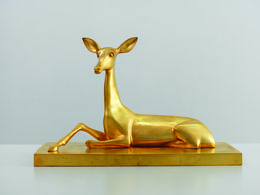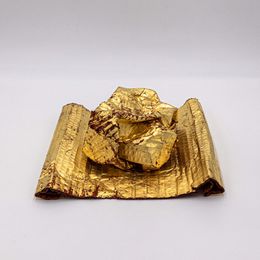
Golden Touch
Gold, forever considered one of the world's most precious metals, has fascinated us throughout the ages. Its radiant light and energy have become symbols of power, wealth and beauty. Moreover, this precious metal has the advantage of being malleable and resistant, almost imperishable, making it an ideal medium to work with. Despite its rarity, artists have been using gold since time immemorial. Indeed, from Agamemnon's mask in ancient Egypt to Klimt's The Kiss, the history of art is paved with gold. Even as far back as the 12th century, the background of Giotto's altarpiece of the Virgin and Child was covered with yellow gold, representing the divine light that exists within the subjects. Nevertheless, gold is not only a symbol of power, it also inspires passion and spirituality. The spiritual dimension of this precious metal originates from the ancient Egyptians who associated gold with the sun and consequently to the god Ra. The glowing metal was later found in the golden skies of Byzantine icons and Baroque churches, and the halos of their saints. Similarly, in Asia, gold has always played a prominent role in the decoration of sacred art. Gold works very often represent Buddhist deities and beings. Artists used either gold leaf or gold paint, in varying techniques, according to the desired light effect. The use of gold then became more discreet until its reappearance in the 19th century, particularly in sculpture. One of the most famous artists noted for his Midas touch, is Gustav Klimt, a master of the material, who produced a series of gold-leaf paintings during what would become known as his 'Golden Cycle', which are among the most beloved of his works. In 2006, his painting Adèle Bloch-Bauer I fetched $135 million and in the same year a set of five gilded works sold for over $327 million. Yves Klein, better known for his blue works, discovered the art of gilding while working for a framer in 1949. Ten years later, this material appeared in his monochrome works, the Monogolds. These canvases covered in thin gold leaves, delicately layered on top of each other, reveal that gold alone is enough to transform an object into a work of art. In the form of currency, gold is a promise of eternal wealth. In terms of its use in art, Klein says that gold 'permeates the painting and gives it eternal life'. So gold isn't only traded on the financial market. If you are not ready to try your luck on the stock market or if the price of gold seems too volatile, Artsper has selected works of art for you that are worth their weight in gold!
Save your search and find it in your favorites
Save your search to find it quickly
Saved search
Your search is accessible from the favorites tab > My favorite searches
Unsaved search
A problem occurred


















